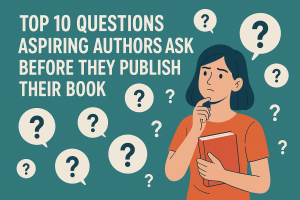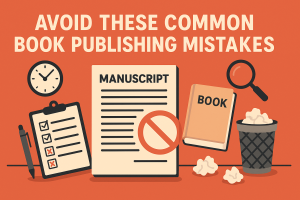The journey to get a book published has transformed dramatically over the past decade, creating both unprecedented opportunities and complex challenges for aspiring and established authors alike. Today’s publishing landscape offers multiple pathways to success, each with its own advantages, requirements, and potential pitfalls. Understanding these options is the first crucial step toward publishing success in an increasingly competitive market.
Modern authors face a publishing ecosystem that has evolved far beyond the traditional gatekeepers of yesteryear. While established publishing houses continue to play a significant role, the rise of independent publishing, hybrid models, and specialized book publishing services has democratized the industry in remarkable ways. Authors now have more control over their creative work than ever before, but this freedom comes with the responsibility of making informed strategic decisions at every stage of the publishing journey.
This comprehensive roadmap is designed to guide authors through the intricate publishing landscape of 2025, providing in-depth insights into each available pathway. Whether you’re a first-time author with a completed manuscript or an established writer looking to leverage new opportunities, understanding the full spectrum of publishing options is essential to making choices aligned with your creative vision, career goals, and financial resources.
The modern author’s journey is not simply about producing a manuscript and hoping for the best—it’s about strategically positioning your work in a crowded marketplace, building meaningful connections with readers, and establishing a sustainable author platform that can support long-term success. By approaching publishing as both an art and a business, today’s authors can navigate the complex terrain with confidence and purpose.
Understanding Your Publishing Options: Traditional, Independent, and Hybrid Approaches
The Evolving Role of Traditional Publishers
Despite significant industry disruption, traditional publishing remains a powerful avenue for authors seeking wide distribution, professional development, and established credibility. Major publishing houses offer comprehensive services including editorial development, cover design, marketing support, and distribution infrastructure that can be difficult to replicate independently.
The traditional publishing process typically begins with securing literary representation through an agent who serves as both advocate and industry navigator. Agents provide crucial market insights, negotiate favorable contract terms, and position manuscripts with appropriate editors. This pathway offers significant advantages, including financial advances against future royalties, professional editorial guidance, and established distribution channels that can place books in physical retail locations worldwide.
However, traditional publishing also comes with significant challenges, including highly competitive submission processes, limited acceptance rates, and reduced creative control over elements like cover design, pricing, and marketing strategy. Authors pursuing this path must be prepared for potentially lengthy timelines—often 18-24 months from acceptance to publication—and royalty structures that typically range from 8-15% of retail price for print books and 25-50% for digital editions.
Recent innovations within traditional publishing include more specialized imprints focused on particular genres or audiences, increased openness to authors who have built platforms independently, and more flexible contract structures that acknowledge the changing marketplace. While securing a traditional deal remains challenging, publishers increasingly recognize the value of authors who approach the relationship with entrepreneurial mindsets and established readerships.
The Independent Publishing Revolution
Independent publishing—often called self-publishing—has evolved from a last resort option to a legitimate first-choice pathway for authors seeking creative control, higher royalty percentages, and accelerated publication timelines. Advances in digital publishing platforms, print-on-demand technology, and specialized book publishing services have created a robust ecosystem supporting independent authors.
This pathway places complete creative and business control in the author’s hands, allowing decisions about editing, cover design, pricing, distribution, and marketing strategy to remain entirely with the creator. Financial models differ significantly from traditional arrangements, with authors making upfront investments in production services but retaining 70% or more of revenue on digital sales and varying percentages on print editions depending on production and distribution arrangements.
Successful independent authors approach publishing with an entrepreneurial mindset, recognizing that they are effectively creating a small business around their creative work. This requires developing multiple competencies or strategically outsourcing services like developmental editing, copyediting, cover design, formatting, and marketing. Affordable book publishing services have emerged to fill these needs, offering à la carte and package options that allow authors to maintain control while accessing professional expertise.
The independent pathway offers unmatched speed-to-market, with books potentially available to readers within weeks of completion rather than years. This accelerated timeline allows authors to respond to market trends, build catalog depth more quickly, and establish more direct relationships with readers. However, it also places the full burden of quality control and marketing on the author’s shoulders, requiring significant investment of time, resources, and entrepreneurial energy.
Exploring Hybrid Publishing Models
Between traditional and independent paths lies a growing sector of hybrid publishing options that combine elements of both approaches. These arrangements take various forms, from established publishing companies offering service-based contracts to cooperative publishing ventures where authors and publishers share both costs and revenues according to negotiated terms.
Hybrid publishers typically offer professional production services, selective acquisition processes, and expanded distribution capabilities compared to pure self-publishing, while providing higher royalty percentages and greater creative control than traditional arrangements. These models appeal to authors seeking the production quality and distribution advantages of traditional publishing combined with the entrepreneurial aspects of independent publishing.
When evaluating hybrid opportunities, authors must carefully distinguish between legitimate hybrid publishers and vanity presses that charge substantial fees without providing commensurate value. Legitimate hybrid partners offer transparent contracts, demonstrated market success, and clear value propositions regarding distribution capabilities and marketing support. Industry watchdog organizations have established certification standards for hybrid publishers that can help authors identify reputable partners.
The hybrid model continues to evolve as the industry adapts to changing market dynamics, creating innovative partnership structures that align publisher and author interests. For authors with entrepreneurial mindsets, substantial platforms, or specialized content, these arrangements can provide strategic advantages that neither traditional nor fully independent models offer alone.
The Essential Elements of Publishing Success: Beyond the Manuscript
Creating a Marketable Manuscript
Before considering publishing pathways, authors must invest in creating truly market-ready manuscripts that can compete in an increasingly crowded marketplace. Publishing success begins with a compelling, well-crafted book that meets or exceeds reader expectations within its genre or category.
Professional developmental editing represents one of the most valuable investments authors can make, providing objective analysis of structural elements, character development, pacing, and other fundamental aspects of the work. Unlike friends or family who may hesitate to offer constructive criticism, professional editors bring industry expertise and reader perspective that can transform promising manuscripts into market-ready products.
Beyond developmental considerations, technical elements like grammar, punctuation, and stylistic consistency require professional attention through copyediting and proofreading services. Even the most talented writers benefit from these specialized forms of editing, which identify issues ranging from minor typographical errors to inconsistencies in character names, settings, or timeline details that can undermine reader trust.
Regardless of publishing pathway, investing in professional editing services significantly increases a book’s market potential by ensuring it meets industry standards and reader expectations. Many affordable book publishing services offer tiered editing packages that allow authors to access appropriate levels of editorial support within various budget constraints.
Building Author Platform and Market Presence
In today’s publishing landscape, an author’s platform—their ability to reach and engage potential readers—has become as important as the manuscript itself. Publishers of all types increasingly evaluate authors based on their existing audience connections and marketing capabilities alongside their creative work.
Effective platform building begins with identifying your core readership and establishing genuine connections through appropriate channels. This might include content marketing through blogs or newsletters, engagement on social media platforms popular with your target audience, podcast appearances, speaking engagements, or collaborative projects with established creators in adjacent spaces.
The most successful author platforms are built on authentic connection rather than merely promotional activity. By providing genuine value to potential readers before asking for their attention or purchasing commitment, authors establish trust relationships that support long-term career development beyond individual book projects. This approach requires consistent, strategic engagement rather than sporadic promotional bursts around launch periods.
Platform development should begin long before publication, ideally at least 6-12 months before a book reaches the market. This timeline allows for organic audience growth and relationship building that creates a receptive foundation for launch activities. Many book publishing services now offer platform development coaching and implementation support to help authors navigate this crucial aspect of publishing success.
Understanding the Economics of Publishing
Financial literacy represents a critical but often overlooked element of publishing success. Authors must understand the economic realities of various publishing models to make informed decisions aligned with their business and creative goals.
In traditional publishing, authors typically receive advances against future royalties, ranging from modest four-figure sums to substantial six or seven-figure payments for established authors or highly anticipated works. These advances represent the publisher’s financial investment in the project, reflecting their assessment of the book’s market potential. Royalty rates for hardcover books typically range from 10-15% of retail price, paperbacks from 6-8%, and ebooks from 25-50%, with payments beginning only after the advance has been fully earned out through sales.
Independent publishing operates on fundamentally different economics, with authors making upfront investments in production services but retaining 70% or more of revenue from digital sales and varying percentages from print sales after production and distribution costs. This model eliminates advances but can potentially generate higher per-unit revenue, especially for ebooks and directly sold print editions.
Book publishing services offer various financial models, from flat fee arrangements for specific services to package deals that combine multiple production elements. When evaluating these options, authors should consider not only immediate costs but long-term revenue implications, including rights retention, royalty structures, and contract duration.
Understanding these economic structures allows authors to make realistic projections about potential returns on investment, whether measured in advance payments, royalty income, or platform-building opportunities. This financial clarity supports strategic decision-making throughout the publishing journey.
Production Excellence: Creating a Professional Product
Professional Editing: The Foundation of Quality
No element contributes more significantly to a book’s success than professional editing, which transforms promising manuscripts into market-ready products capable of competing with titles from major publishing houses. The editing process occurs in distinct phases, each addressing different aspects of the manuscript.
Developmental editing addresses structural elements such as plot coherence, character development, pacing, and thematic clarity. For nonfiction, this includes logical flow, argument structure, and content organization. This macro-level editing often involves substantial revision and restructuring to strengthen the work’s fundamental elements.
Copyediting focuses on sentence-level improvements, addressing grammar, punctuation, stylistic consistency, and factual accuracy. A skilled copyeditor preserves the author’s voice while eliminating technical errors and inconsistencies that undermine reader experience. For specialized content, copyeditors with subject matter expertise ensure accuracy in terminology and concepts.
Proofreading represents the final quality control stage, catching remaining typographical errors, formatting inconsistencies, and other minor issues before publication. This detailed review examines everything from chapter headings and page numbers to font consistency and proper citation formatting.
Authors seeking to get a book published should budget appropriately for these essential services, recognizing that professional editing represents an investment in the book’s market potential rather than merely an expense. Many affordable book publishing services offer tiered editing packages that allow authors to access appropriate levels of support within various budget constraints.
Cover Design: The Visual Gateway to Your Book
Despite the adage about judging books by their covers, readers inevitably form initial impressions based on visual presentation. Professional cover design communicates genre expectations, tone, and production quality before a reader reads a single word. In physical retail environments, covers have approximately three seconds to capture attention; in digital marketplaces, that window shrinks to milliseconds as readers scroll through thumbnail images.
Effective cover design begins with comprehensive market research examining successful titles in your specific category or genre. This research identifies visual conventions that signal genre appropriateness to target readers—elements that might include typography styles, color palettes, image treatment, and composition approaches. While originality matters, covers that deviate too dramatically from genre expectations often confuse potential readers.
Beyond genre considerations, covers must function effectively across multiple formats and display environments. Designs must remain legible and impactful as small thumbnails in online stores, on e-reader displays, as physical paperbacks, and potentially as hardcover editions with jackets. This multi-format functionality requires sophisticated design approaches that consider various presentation contexts.
Professional designers bring both aesthetic talent and market knowledge to this crucial element, creating covers that attract appropriate readers while accurately representing the book’s content and tone. Book publishing services typically offer design packages ranging from basic template-based approaches to fully custom designs with multiple concept options and revision rounds.
Interior Design and Formatting: The Reading Experience
While covers capture initial attention, interior design and formatting create the actual reading experience. Professional interior design ensures appropriate typography, spacing, chapter headings, and special elements that facilitate comfortable reading while maintaining professional presentation standards.
For print books, interior design addresses technical considerations like margin specifications that accommodate binding methods, page number placement, running heads or footers, and special elements like charts, illustrations, or photographs. Different genres have established conventions regarding these elements, from the clean simplicity of literary fiction to the more complex layouts often found in instructional nonfiction.
Digital formatting requires specialized expertise to ensure proper functioning across multiple e-reading platforms with varying display capabilities. Professional e-book formatting creates files that adapt appropriately to different screen sizes, user font preferences, and platform-specific requirements while maintaining consistent presentation of special elements.
Many book printing companies offer integrated design packages that ensure consistency between exterior and interior elements, creating a cohesive visual identity for the book across all formats. These professional design services significantly influence reader experience and perceived value, directly impacting reviews, recommendations, and long-term sales potential.
Distribution Strategies: Getting Your Book to Readers
Digital Distribution Platforms and Strategies
E-book and digital audiobook distribution has transformed publishing economics by reducing production and distribution costs while allowing precise targeting of reader segments. Developing a comprehensive digital distribution strategy represents a crucial element of publishing success for authors across all publishing paths.
Major retail platforms like Amazon’s Kindle Store, Apple Books, Barnes & Noble’s Nook, Kobo, and Google Play provide access to global markets through straightforward distribution processes. Authors can reach these platforms either directly through individual portal accounts or through aggregation services that distribute to multiple retailers through single upload processes.
Beyond mainstream retailers, specialized platforms serve particular genres, formats, or business models. Subscription services like Kindle Unlimited and Scribd operate on different economic models than traditional retail, offering authors access to readers who prefer all-you-can-read subscription approaches. Direct sales platforms allow authors to sell directly to readers, retaining higher percentages of revenue and capturing valuable customer data for marketing purposes.
Effective digital distribution involves not merely making books available but strategically positioning them through metadata optimization, pricing strategies, and promotional scheduling. Keywords, categories, series organization, and book descriptions significantly influence discoverability in algorithmic environments, requiring thoughtful optimization and regular refinement based on performance data.
Print Distribution: From Print-on-Demand to Traditional Wholesale
Despite the growth of digital reading, print books remain a significant market segment offering unique advantages for author branding, reader acquisition, and revenue diversification. Modern print distribution options range from cost-effective print-on-demand services to traditional wholesale models involving inventory production and management.
Print-on-demand technology has revolutionized independent publishing by eliminating inventory requirements and upfront printing costs. Services from companies like Amazon KDP Print, IngramSpark, and specialized book printing companies allow books to be produced individually as orders are placed, enabling global print distribution without inventory investment. While per-unit costs are higher than traditional print runs, the elimination of storage costs and inventory risk makes this approach ideal for independent authors and small presses.
For books with established demand, traditional offset printing offers lower per-unit costs and enhanced production options including specialty papers, sophisticated cover treatments, and custom trim sizes. This approach requires significant upfront investment and inventory management but can substantially improve unit economics for books with predictable demand patterns.
Expanded distribution to physical retail locations requires strategic partnerships with distributors who maintain relationships with bookstores, specialty retailers, and institutional purchasers. Major distributors like Ingram provide comprehensive channel access but typically require standard trade discounts of 55% and returnability policies that create additional financial considerations for publishers and authors.
Audiobook Production and Distribution
Audiobooks represent the fastest-growing segment of the publishing market, offering significant revenue and audience expansion opportunities for authors across genres. While historically limited to bestselling titles due to high production costs, technological advances and specialized service providers have made audiobook creation accessible to more authors.
Professional audiobook production involves narrator selection, studio recording, editing, mastering, and quality control processes that ensure listening experiences comparable to traditionally published titles. Costs vary significantly based on narrator experience, production quality, and book length, with professional productions typically requiring investments ranging from $1,000 to $5,000 for average-length books.
Distribution options include exclusive arrangements with Audible through their ACX platform, which dominates market share but imposes significant restrictions, and broader distribution through aggregators like Findaway Voices that reach multiple retail and library platforms. Each approach offers different royalty structures, term commitments, and market access considerations that authors must evaluate based on their specific goals and resources.
Several book publishing services now offer integrated audiobook production and distribution packages, creating opportunities for authors to expand their format offerings without navigating complex production processes independently. For authors with performance backgrounds, self-narration options with professional engineering support can reduce production costs while creating unique listening experiences.
Marketing Mastery: Building Visibility and Driving Sales
Strategic Book Launch Planning
Successful book launches require comprehensive planning that begins months before publication date, coordinating multiple marketing elements to create maximum visibility during the crucial initial release period. Effective launch strategies coordinate content marketing, media outreach, promotional activities, and strategic pricing to create momentum that algorithms and recommendation systems can amplify.
Pre-launch activities focus on building anticipation among established audiences through content marketing, cover reveals, excerpt sharing, and advance reader programs that generate initial reviews. Many authors use preorder campaigns to consolidate early sales impact, improving visibility through bestseller list placement and algorithmic recommendation triggers.
Launch week activities typically include promotional pricing, coordinated newsletter features, podcast appearances, social media campaigns, and targeted advertising that drives concentrated attention during this critical visibility window. The specific mix of tactics varies based on genre, target audience, and author platform characteristics.
Post-launch sustainability planning prevents the common “sales cliff” experienced after initial promotion ends. This includes scheduled promotional activities, content marketing continuation, and strategic use of advertising to maintain visibility while the book establishes organic discovery patterns through reviews and reader recommendations.
Book publishing services increasingly offer launch planning and implementation support, providing authors with strategic guidance and tactical implementation assistance that leverages industry expertise and established promotional channels. These services range from basic planning templates to comprehensive campaign management handling all aspects of launch execution.
Building Effective Author Websites and Email Marketing
In an increasingly fragmented digital landscape, owned marketing channels—particularly author websites and email newsletters—provide stability and direct reader connections that social media platforms cannot match. These assets represent fundamental infrastructure for sustainable author careers rather than merely book promotion tools.
Professional author websites serve multiple crucial functions: providing comprehensive information about available books, capturing email subscribers, hosting content marketing materials, facilitating direct sales, and establishing professional credibility. Effective sites balance aesthetic appeal with functional design that facilitates visitor conversion to subscribers or customers.
Email marketing remains the most effective digital marketing channel by significant margins, delivering average returns of $36-$42 for every dollar invested according to industry research. Building and nurturing subscriber lists through compelling content offers, reader magnets, and consistent value delivery creates marketing assets that appreciate over time rather than requiring continuous investment.
Strategic email marketing involves developing welcome sequences that introduce new subscribers to your work, regular content delivery that maintains engagement, and promotional campaigns that drive purchasing behavior without alienating subscribers through excessive selling. Segmentation based on reader interests, purchase history, and engagement levels allows increasingly personalized communication that improves conversion rates.
Leveraging Book Reviews and Reader Advocacy
Reader reviews function as both social proof and algorithmic currency in today’s publishing ecosystem, significantly influencing both human purchasing decisions and recommendation system behavior. Developing systematic approaches to generating legitimate reviews represents a crucial element of sustainable book marketing.
Advance reader programs identify and nurture relationships with engaged readers willing to provide honest reviews during launch periods. These programs range from informal arrangements with existing audience members to structured programs using specialized platforms that facilitate digital ARC (advance reader copy) distribution and review management.
Strategic review solicitation continues beyond launch through appropriately placed requests in book back matter, email communications, and occasional direct outreach to engaged readers. These approaches must carefully balance effectiveness with ethical considerations and platform policies regarding review solicitation.
Beyond quantity, review sentiment and specificity significantly influence conversion, with detailed positive reviews carrying substantially more persuasive power than brief generic endorsements. By encouraging detailed feedback from satisfied readers, authors can build review portfolios that effectively communicate book value to potential purchasers.
Advertising Strategies for Book Promotion
Strategic advertising transforms publishing success potential by accelerating discovery and amplifying organic marketing efforts. While advertising alone rarely creates sustainable sales patterns, properly executed campaigns can significantly enhance visibility during critical periods while providing valuable market data that informs broader strategy.
Platform selection should align with target audience characteristics and book genre, with major options including Amazon Advertising, BookBub Featured Deals and display ads, Facebook/Instagram advertising, and search engine marketing through Google Ads. Each platform offers distinct targeting capabilities, cost structures, and performance patterns that must be evaluated against specific marketing objectives.
Effective campaigns require clear objective definition, whether focused on new release visibility, backlist revival, series funnel building, or audience expansion. These objectives inform campaign structure, targeting approaches, budget allocation, and success metrics appropriate to the specific goal.
Creative development for advertising requires specialized approaches that differ from general book marketing, with successful ads typically featuring concise benefit-focused copy, social proof elements, and visually appealing graphics optimized for specific platform environments. Testing multiple creative variations enables performance optimization and market insight development.
Future-Proofing Your Publishing Career: Beyond the First Book
Building Sustainable Author Businesses
Publishing success increasingly requires authors to adopt business mindsets that extend beyond individual book projects to develop sustainable creative enterprises. This approach involves strategic planning across multiple dimensions including intellectual property development, business structure establishment, and long-term career mapping.
Business planning begins with clarity about desired outcomes, whether focused on creative fulfillment, financial success, audience impact, or combinations of these goals. These objectives inform decisions about publishing pathways, investment priorities, and strategic partnerships that align with long-term vision rather than merely short-term opportunities.
Rights management represents a crucial business consideration, with authors increasingly recognizing the value of maintaining control over subsidiary rights including foreign language translations, audio adaptations, film/TV options, and merchandising opportunities. These additional revenue streams can significantly enhance author income while extending brand reach across multiple platforms and territories.
Financial management systems support sustainable operations through appropriate business structures, accounting practices, and tax planning that legitimize author activities while optimizing financial outcomes. Professional advisors with publishing industry expertise can provide valuable guidance on these technical but essential business elements.
Series Development and Strategic Publication Scheduling
For many authors, particularly in fiction categories, series development represents the most reliable path to sustainable success. Well-executed series create multiple reader entry points, enable more efficient marketing through product bundling, and establish predictable reader purchase patterns that support career development.
Strategic series planning involves thoughtful worldbuilding, character development arcs that span multiple volumes, and narrative structures that balance individual book satisfaction with overarching story progression. This planning extends to practical considerations including consistent branding, predictable release scheduling, and progressive marketing approaches that build momentum across successive releases.
Publication scheduling significantly impacts market performance, with factors including seasonal buying patterns, competitive release timing, and platform algorithm behaviors influencing optimal launch windows. Many successful authors develop annual publication calendars that strategically position releases to maximize visibility and sales potential throughout the year.
For authors working with affordable book publishing services, coordinating production timelines across multiple projects requires careful planning to ensure consistent quality while maintaining publication schedules. Many service providers offer package arrangements that facilitate efficient multi-book production while ensuring consistent quality across series entries.
Adapting to Industry Evolution and Technological Change
The publishing landscape continues evolving rapidly, with technological innovations, market consolidation, and consumer behavior shifts creating both challenges and opportunities for authors. Developing adaptive mindsets and continuous learning practices enables authors to navigate this dynamic environment while identifying emerging opportunities.
Industry monitoring practices help authors track relevant developments through trade publications, professional associations, author communities, and market analysis. This ongoing education informs strategic adjustments as distribution channels evolve, promotional effectiveness shifts across platforms, and new format opportunities emerge.
Technological adoption involves balanced evaluation of emerging tools and platforms, neither chasing every new development nor resisting beneficial innovations. Strategic assessment of potential impact on production efficiency, marketing effectiveness, and reader experience guides implementation decisions that enhance competitive positioning without creating unsustainable complexity.
Community connection with other authors, industry professionals, and service providers creates valuable networks for information sharing, opportunity identification, and collaborative ventures. These relationships provide both practical insights and emotional support through publishing challenges while creating potential for cooperative marketing and audience-sharing initiatives.
Conclusion: Charting Your Unique Publishing Journey
The modern author’s path to publishing success involves navigating complex decisions that align creative vision with market realities. By understanding the full spectrum of available options—from traditional publishing relationships to independent publishing approaches to hybrid models—authors can make informed choices that support their specific goals, resources, and creative priorities.
Regardless of publishing pathway, certain fundamental elements determine success potential: manuscript quality that meets or exceeds market standards, professional production values that signal quality to potential readers, strategic marketing approaches that build sustainable visibility, and business mindsets that support career longevity beyond initial publications.
The democratization of publishing through accessible technology and affordable book publishing services has created unprecedented opportunities for authors to reach readers directly, control creative destinies, and build sustainable careers without traditional gatekeeping. However, this freedom comes with responsibility for making informed decisions across multiple dimensions of the publishing process.
By approaching author careers as legitimate creative businesses—with appropriate investment in professional services, strategic planning, and continuous learning—modern authors can navigate the complex publishing landscape with confidence and purpose. The roadmap presented here provides guidance for this journey, offering insights that support informed decision-making across the publishing spectrum.
The most successful authors recognize that publishing represents not merely a single transaction but an ongoing relationship with readers, the marketplace, and their own creative development. By embracing this perspective, authors transform publishing challenges into opportunities for growth, connection, and sustainable creative expression that resonates with readers while supporting fulfilling creative careers.






